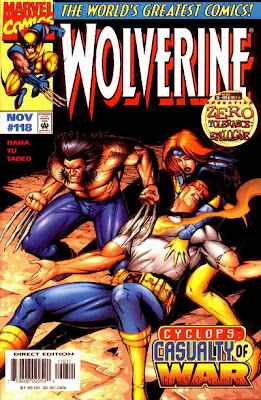 X-Men #72
X-Men #72 Life Lessons
Credits: Joe Kelly (writer), Carlos Pacheco (penciler), Art Thibert (inker), Comicraft (lettering), Liquid! (colors)
Summary: Wolverine spars with Marrow, testing her to see if she’s truly willing to become an X-Man. When he thinks that she’s willing to submit, Marrow sucker punches him and stabs him in the throat. Wolverine goes into a rage, and is subdued by Cannonball. Marrow runs away, back to the secret place where Callisto is recovering. Meanwhile, Sabra informs Gabrielle Haller that Erik Lensherr was a false identity created for Magneto. They track down Georg Odekirk, the man who created the counterfeit identity, shortly after he's killed by Magneto.
Continuity Notes: Gabrielle Haller is trying to use her influence as an ambassador to free Xavier from federal custody. It’s amusing that she’s more concerned about this than the X-Men seem to be (although Phoenix does briefly search for him mentally in this month's UXM).
Storm tells Cannonball that Marrow “attempt(ed) to kill hundreds to further her goals”, which seems to be a quiet retconning of any actual murders on her part.
According to Magneto, he changed his name to Erik Lensherr after he went into hiding, following his lethal attack on his daughter’s killers. He kills Georg Odekirk because the identity he created doesn’t stand up to scrutiny in the modern age.
Review: This issue is almost entirely dedicated to justifying Marrow’s place on the team, which isn’t an easy thing to pull off. There is at least a little retconning going on, but Kelly really doesn’t go for any cheap outs. Marrow doesn’t break down and cry, Storm doesn’t decide to forgive and move on, and Wolverine doesn’t get to intimidate Marrow into falling in line. Marrow remains nasty and mean, with the only indication that she’s willing to change coming from Wolverine’s speculation that “somewhere in that mess you call a brain, part of you wants something better”. Having Marrow stab Wolverine just when he seems to be getting through to her is a nice twist. It might come across as Kelly selling Marrow a little too hard, but I think it works within the context of the story. Cannonball also has a strong portrayal, as he tries to convince the others to follow Xavier's example and give Marrow a second chance, even when there’s no compelling reason for the team to do so. I still think adding Marrow to the team was a dumb move, but Kelly gets a lot of material out of the idea in this issue.
The Magneto subplot, on the other hand, is just ridiculous. I assume it was motivated by Marvel retroactively deciding that too much of Magneto’s past had been revealed, which might be a legitimate concern. Casually revealing that Erik Lensherr was a fake name, and having Magneto callously kill the man who created it, doesn’t work at all. It brings Magneto back into cartoonish supervillainy, which undermines most of the interesting things you can do with the character.
In Sin Air
Credits: Steve Seagle (writer), Hamner/Edwards/Banks/Dodson/
Summary: While flying to their new home in Alaska, Cyclops and Phoenix encounter an otherworldly entity that AIM is attempting to steal from another group of scientists. At first, the entity lashes out at the passengers, forcing them to relive their darkest moments. When the plane goes out of control, Phoenix convinces the entity to find the good in humanity and calm the passengers, allowing the pilot to land the plane. Meanwhile, Archangel returns to the X-Men’s mansion, but receives a cold reception from teammates who feel that he isn’t taking his responsibilities seriously.
Review: This is another issue that reads like filler, although it’s enjoyable enough. It’s probably most notable for containing six pencilers and six inkers, which makes me wonder just how far off-schedule this title was at the time. I think this is John Cassady’s first time drawing the X-Men, although his style is so different than his Astonishing X-Men work, it might as well be a different artist. None of the pencilers in this issue are incompetent, but their styles are all over the place, and pages seem to have been assigned at random. A three-page scene that has Archangel getting told off by the X-Men somehow ends up with two different artists with totally incompatible styles, making the issue seem like even more of a rush job. I don’t care for the Archangel subplot, which goes out of its way to make him a self-centered goof, but the main story has its moments. I like the psychological angle Seagle adds to the story, and introducing normal, human neighbors for the Summers is a good idea (which, unfortunately, was quickly dismissed).





















